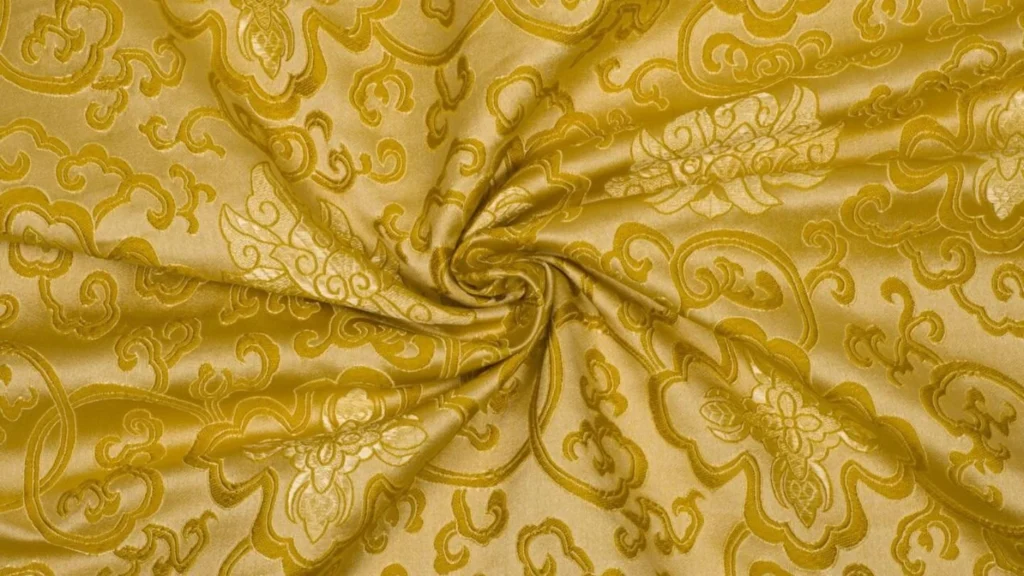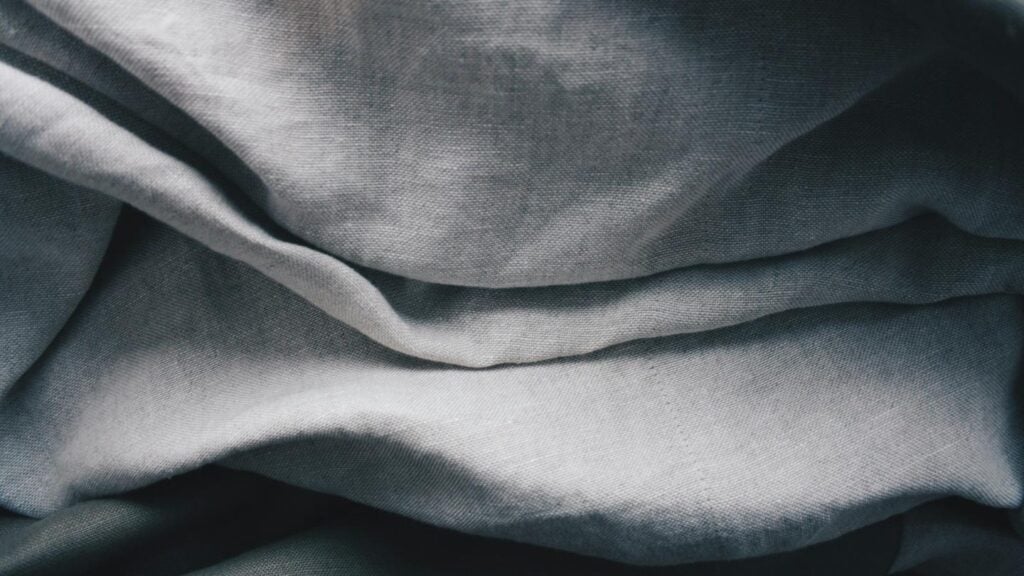2 – Benefits of Choosing Cashmere
3 – Cashmere vs Other Fabrics
4 – How Cashmere Is Manufactured
5 – Common Uses in Fashion
6 – Understanding the Environmental Impact of Cashmere
7 – Exploring Price Points and Value for Money
8 – Conclusion
9 – FAQs
What is Cashmere?
Cashmere is a luxurious natural fiber obtained from the soft undercoat of cashmere goats, primarily raised in the cold, mountainous regions of Mongolia, Nepal, and Northern China. Unlike wool from sheep, which is coarser and thicker, cashmere is prized for its exceptional softness, warmth, and lightweight feel. It takes the fine, insulating hairs that goats grow to survive extreme winters—hairs that are painstakingly collected by hand during the molting season in spring.
Here’s what makes cashmere unique:
- Natural origin: Derived from the underfleece of goats (not sheep), especially breeds like the Capra Hircus Laniger.
- Exceptional softness: Fibers are extremely fine, typically under 19 microns in diameter—finer than human hair—making cashmere feel incredibly smooth against the skin.
- Thermal performance: Provides up to 8 times more warmth than regular wool while remaining breathable and lightweight.
- Labor-intensive harvesting: One goat produces only about 150 grams of usable cashmere per year—enough for roughly one scarf.
- Timeless appeal: Revered for centuries, especially in luxury fashion, for its elegance, comfort, and natural durability.
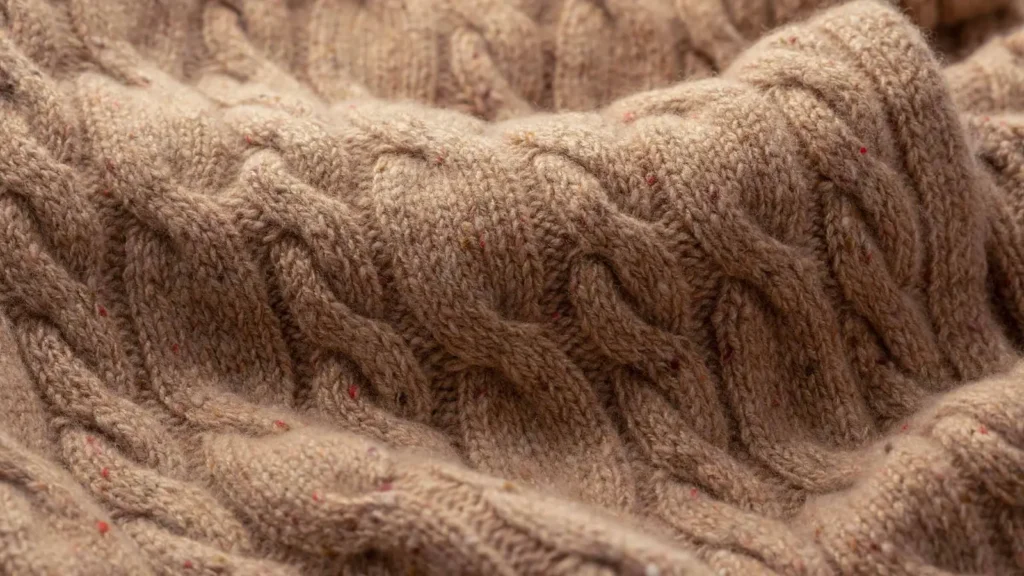
Benefits of Choosing Cashmere
Choosing cashmere means investing in one of the most refined and comfortable natural fibers available. Whether for a wardrobe staple or a luxury statement piece, here are the key advantages of wearing cashmere:
- Unmatched Softness
Cashmere is renowned for its silky feel and gentle touch on the skin, offering superior comfort compared to regular wool or synthetic alternatives. - Natural Warmth Without Bulk
Despite being lightweight, cashmere provides exceptional insulation—up to 8 times warmer than traditional wool—making it perfect for layering without added bulk. - Breathable and Moisture-Regulating
The natural fibers allow airflow and wick moisture, helping to regulate body temperature and keep you comfortable in both cold and mild climates. - Hypoallergenic
Unlike some wool types, cashmere lacks lanolin, which makes it a gentle choice for sensitive skin or those prone to irritation. - Durability and Longevity
With proper care, cashmere garments can last for decades, becoming softer over time while retaining their shape and elegance. - Timeless Luxury
Cashmere never goes out of style. It conveys quiet sophistication and is often seen as a symbol of refined taste and conscious consumption. - Sustainable Value
High-quality cashmere, especially when responsibly sourced, supports traditional herding communities and often comes from low-impact, low-volume production models.

Cashmere vs Other Fabrics
Cashmere offers a distinct set of advantages compared to other common fabrics. Here’s how it stacks up:
- Cashmere vs Wool
- Cashmere is softer, warmer (up to 8x), and lighter.
- Wool is more durable and affordable but coarser.
- Cashmere vs Merino Wool
- Both are soft and breathable.
- Cashmere is warmer and more luxurious; merino is more elastic and easier to care for.
- Cashmere vs Cotton
- Cotton is breathable and ideal for warm climates.
- Cashmere is better for cold weather, offering far more insulation.
- Cashmere vs Synthetic Fabrics (e.g., polyester, acrylic)
- Synthetics are cheaper and durable but less breathable and less soft.
- Cashmere is natural, breathable, and luxurious, but needs more care.
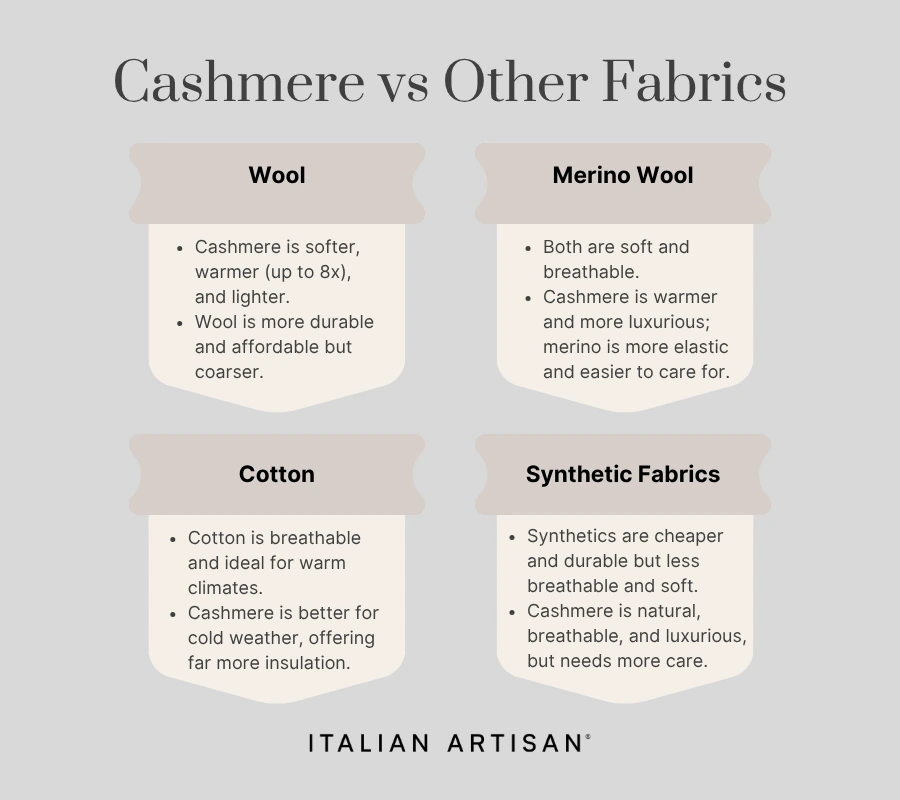
How Cashmere Is Manufactured
Cashmere production is a labor-intensive process rooted in traditional herding and craftsmanship. Here’s how it moves from goat to garment:
- Combing the Undercoat
- Each spring, cashmere goats naturally shed their soft undercoat.
- Herders hand-comb the goats to collect the fine hairs—this is gentler and more sustainable than shearing.
- One goat yields only 150–200 grams of usable cashmere per year.
- Sorting the Fibers
- Raw fleece contains both coarse guard hairs and fine undercoat.
- The fibers are manually sorted to separate the ultra-soft down from the rougher hairs.
- Only the finest fibers (under 19 microns in diameter) are used for premium cashmere.
- Washing and Dehairing
- The raw cashmere is washed to remove grease, dirt, and impurities.
- A dehairing machine removes remaining coarse hairs while preserving the fine ones.
- Spinning
- The clean, pure fibers are carded and then spun into yarn.
- Quality spinning ensures durability and softness, influencing the final texture and pilling resistance.
- Dyeing
- Yarn can be dyed at various stages (fiber, yarn, or fabric) depending on color depth and quality control needs.
- Natural or eco-friendly dyes are often used in sustainable cashmere production.
- Knitting or Weaving
- The yarn is then knitted or woven into garments such as sweaters, scarves, or coats.
- Fine craftsmanship at this stage defines the feel, drape, and longevity of the piece.
- Finishing
- Final steps may include brushing, steaming, or washing to enhance softness and shape retention.
- Quality checks are performed to ensure consistency and excellence.

Produce your fashion collection with us
Common Uses in Fashion
Cashmere’s softness, warmth, and lightweight feel make it a staple in luxury fashion. It’s favored not just for cold-weather clothing, but also for year-round pieces that combine comfort and elegance. Here are the most common uses:
- Sweaters & Pullovers
- The most iconic use of cashmere—soft, warm, and lightweight layers perfect for everyday wear or elevated outfits.
- Scarves & Shawls
- Popular for their featherlight feel and cozy warmth, cashmere scarves are a signature luxury accessory.
- Cardigans & Knitwear Sets
- Often paired with skirts or trousers for a refined, coordinated look, cashmere knitwear sets are beloved in both casual and office wardrobes.
- Coats & Outerwear
- High-end brands use cashmere (often blended with wool) to create soft, structured coats that insulate without heaviness.
- Dresses & Skirts
- Fine-gauge cashmere is used in fitted or flowing silhouettes, ideal for fall/winter collections.
- Loungewear & Travel Sets
- Cashmere joggers, hoodies, and robes are increasingly popular for luxury comfort at home or in transit.
- Socks, Hats & Gloves
- Accessories like beanies, mittens, and socks in cashmere add a soft, insulating layer that’s also breathable and gentle on skin.
- Blankets & Wraps
- While not worn, these home and travel essentials reflect cashmere’s crossover into lifestyle luxury.
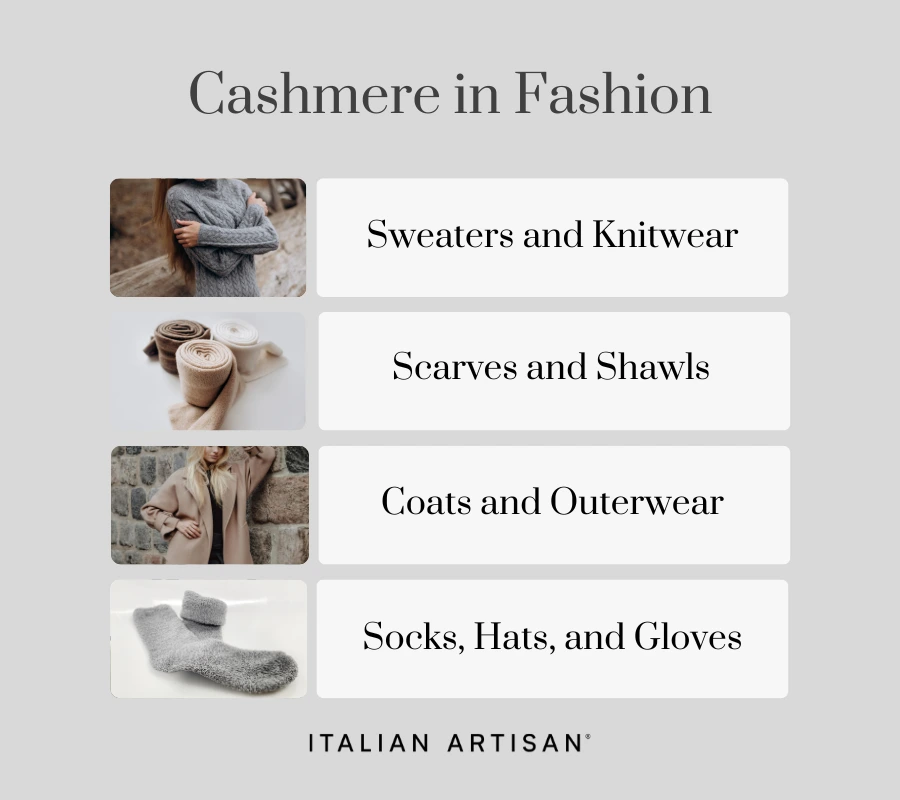
Understanding the Environmental Impact of Cashmere
While cashmere is celebrated for its luxury and softness, its environmental impact has drawn increasing scrutiny. As demand for this rare fiber grows, it’s important to understand both the challenges and the sustainable alternatives emerging in the industry.
1. Overgrazing and Land Degradation
- Cashmere goats graze extensively and pull grass up from the roots, unlike sheep that nibble the top.
- In regions like Mongolia, this has led to overgrazing, soil erosion, and desertification, especially with rising herd populations to meet global demand.
2. High Resource Intensity
- Each goat yields only a small amount of usable fiber (approx. 150g/year), requiring multiple animals per garment.
- This increases pressure on land, food, and water resources in fragile ecosystems.
3. Animal Welfare Concerns
- In poorly regulated farms, goats may be sheared aggressively or kept in stressful conditions.
- Ethical producers prioritize combing (a gentler method) and allow goats to graze naturally, aligning with animal welfare standards.
4. Energy and Water Use in Processing
- The production process—especially washing, dyeing, and dehairing—can consume significant water and chemicals if not properly managed.
- Responsible manufacturers adopt closed-loop systems and eco-friendly dyes to reduce impact.
5. Sustainable Alternatives & Certifications
- Regenerative grazing, smaller herds, and biodiversity-focused herding practices are emerging solutions.
- Look for certifications such as:
- The Good Cashmere Standard (animal welfare and social responsibility)
- SFA (Sustainable Fibre Alliance) (environmental and ethical guidelines)
- GOTS and OEKO-TEX® (for responsible dyeing and chemical use)
Exploring Price Points and Value for Money
Cashmere is often considered a luxury material—and its price reflects that. But understanding the true value of cashmere goes beyond the price tag. It involves looking at craftsmanship, longevity, and sourcing quality.
Why Is Cashmere Expensive?
- Limited Supply
- Each cashmere goat produces only 150–200 grams of usable fiber per year. It takes 2 to 4 goats to make just one sweater.
- Labor-Intensive Process
- From hand-combing the undercoat to manual sorting and small-batch spinning, production requires time, skill, and care.
- Sourcing & Ethics
- Responsibly sourced and certified cashmere—especially from producers who prioritize animal welfare and environmental sustainability—costs more to produce.
- Craftsmanship & Design
- High-end brands invest in refined spinning, knitting, and finishing, resulting in garments that resist pilling, hold their shape, and age beautifully.
- High-end brands invest in refined spinning, knitting, and finishing, resulting in garments that resist pilling, hold their shape, and age beautifully.
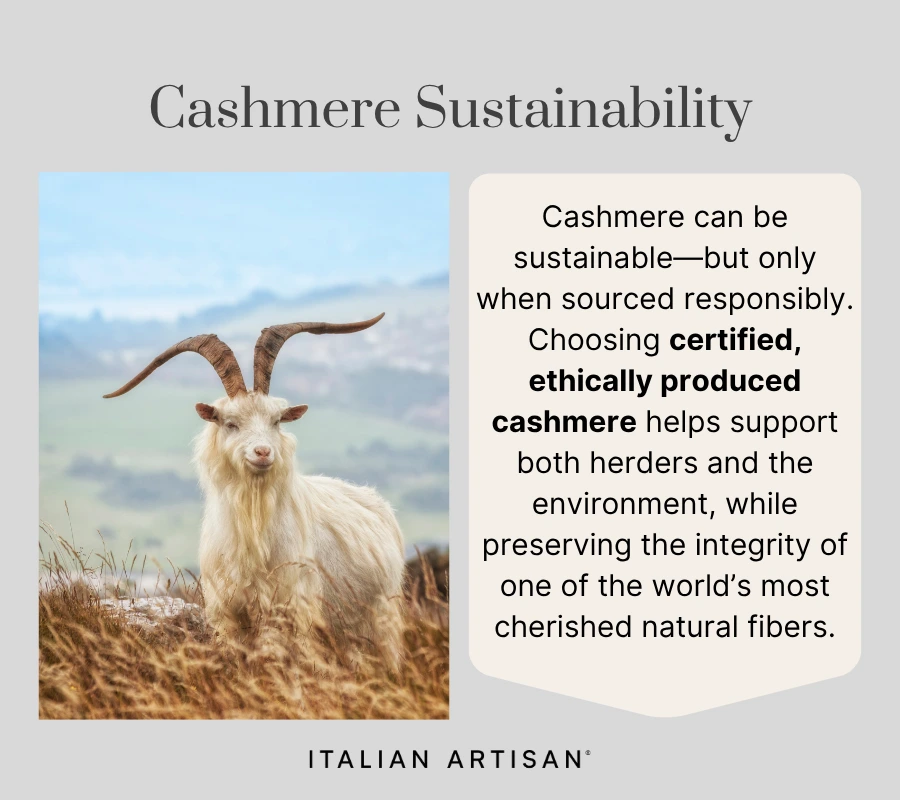
What Do You Get for the Price?
- Longevity
- A well-made cashmere garment can last 10+ years with proper care, making it more cost-effective than fast-fashion alternatives.
- Comfort & Performance
- Cashmere combines lightness, warmth, and softness like no other fabric, offering exceptional everyday luxury.
- Timeless Appeal
- Classic silhouettes and neutral tones make cashmere garments versatile and seasonless, increasing cost-per-wear value.
- Resale & Repair Value
- High-quality cashmere retains resale value and can often be repaired, making it a smart investment for conscious consumers.
Budget Options Exist—But Quality Varies
- Low-cost cashmere often comes from lower-grade fibers, mixed with synthetics or harvested unethically. These garments may pill quickly or lose shape.
- Mid-range brands may offer good quality by reducing margins or simplifying designs—but always check the fiber grade, origin, and brand transparency.

Conclusion
Cashmere is more than a fabric—it’s a blend of natural luxury, exceptional performance, and timeless style. While its production requires care and consideration, choosing high-quality, responsibly sourced cashmere offers lasting value, comfort, and elegance. For those seeking warmth without weight and softness without compromise, cashmere remains an unmatched investment in quality.
FAQs
- What is cashmere?
Cashmere is a soft, warm natural fiber made from the undercoat of cashmere goats, mainly found in Mongolia, China, and Nepal. - Why is cashmere so expensive?
Each goat produces a small amount of fiber, and harvesting is labor-intensive. High-quality cashmere also involves ethical sourcing and skilled craftsmanship. - How is cashmere different from wool?
Cashmere is softer, warmer, and lighter than regular sheep’s wool. It’s also more delicate and often more luxurious. - What is the composition of cashmere?
Cashmere is made of fine keratin fibers from the goat’s undercoat, typically under 19 microns in diameter, which gives it its softness and warmth. - What are the main properties of cashmere?
Cashmere is known for its exceptional softness, warmth, breathability, lightness, and ability to regulate body temperature. - How long does a cashmere garment last?
With proper care, a high-quality cashmere piece can last over 10 years and often becomes softer over time. - Where does the best cashmere come from?
Mongolia and Inner Mongolia (China) are known for producing some of the world’s finest, most sustainable cashmere. - How can I tell if a cashmere product is high quality?
Look for long, tightly woven fibers, a soft but dense texture, and transparency about sourcing and certifications (e.g., GCS or SFA). - Is cashmere sustainable?
It can be, especially when sourced responsibly from certified herders who use regenerative practices and treat animals ethically. - Will cashmere keep me warm in winter?
Yes—cashmere is up to 8 times warmer than wool and provides excellent insulation without the weight.




